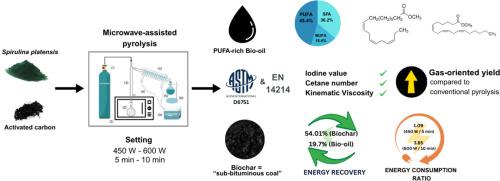Microwave-assisted pyrolysis of Spirulina platensis with activated carbon as absorber: Product yield dynamics and fuel properties
IF 4.5
2区 生物学
Q1 BIOTECHNOLOGY & APPLIED MICROBIOLOGY
Algal Research-Biomass Biofuels and Bioproducts
Pub Date : 2025-09-24
DOI:10.1016/j.algal.2025.104329
引用次数: 0
Abstract
This study investigates the microwave-assisted pyrolysis (MAP) of Spirulina platensis using activated carbon as a microwave absorber, focusing on the effects of microwave power and exposure time on product yields and characteristics. The maximum bio-oil yield (14.42 % ± 0.335 %) was obtained at 600 W for 10 min, and the highest biochar yield (49.39 % ± 1.09 %) at 450 W for 5 min. Statistical analysis confirmed significant main and interaction effects influencing the product yield distribution. The resulting bio-oil and biochar exhibited HHVs of 29.89 MJ/kg and 23.92 MJ/kg, respectively, with corresponding energy recoveries of 19.70 % and 54.01 %, respectively. However, energy consumption ratio indicated that, under the tested conditions, MAP was not energetically favorable when evaluated solely on the basis of biochar and bio-oil. The biochar displayed energy characteristics similar to sub-bituminous coal. FTIR analysis revealed functional groups relevant to fuel chemistry, while fuel property estimates predicted that the bio-oil met EN 14214 and ASTM D6751 standards for iodine value, cetane number, and kinematic viscosity. GC–MS profiling showed a highly polyunsaturated fatty acid content of the bio-oil. These results highlight the potential of S. platensis-derived bio-oil and biochar as sustainable alternatives to conventional fuels and valuable bioproducts.

以活性炭为吸收体的平螺旋藻微波辅助热解:产物产率动态及燃料特性
以活性炭为微波吸收体,研究了微波辅助热解(MAP)对螺旋藻(Spirulina platensis)的影响,重点研究了微波功率和微波暴露时间对产物收率和特性的影响。当温度为600 W、反应时间为10 min时,生物油收率最高(14.42%±0.335%);当温度为450 W、反应时间为5 min时,生物炭收率最高(49.39%±1.09%)。统计分析证实了显著的主效应和交互效应对产品收率分布的影响。所得生物油和生物炭的hhv分别为29.89 MJ/kg和23.92 MJ/kg,能量回收率分别为19.70%和54.01%。然而,能量消耗比表明,在试验条件下,仅以生物炭和生物油为基础进行评价时,MAP在能量上并不有利。生物炭表现出与亚烟煤相似的能量特性。FTIR分析揭示了与燃料化学相关的官能团,而燃料性能估计预测生物油符合EN 14214和ASTM D6751标准的碘值、十六烷值和运动粘度。气相色谱-质谱分析表明,该生物油具有较高的多不饱和脂肪酸含量。这些结果突出了由铂氏葡萄树衍生的生物油和生物炭作为传统燃料和有价值的生物产品的可持续替代品的潜力。
本文章由计算机程序翻译,如有差异,请以英文原文为准。
求助全文
约1分钟内获得全文
求助全文
来源期刊

Algal Research-Biomass Biofuels and Bioproducts
BIOTECHNOLOGY & APPLIED MICROBIOLOGY-
CiteScore
9.40
自引率
7.80%
发文量
332
期刊介绍:
Algal Research is an international phycology journal covering all areas of emerging technologies in algae biology, biomass production, cultivation, harvesting, extraction, bioproducts, biorefinery, engineering, and econometrics. Algae is defined to include cyanobacteria, microalgae, and protists and symbionts of interest in biotechnology. The journal publishes original research and reviews for the following scope: algal biology, including but not exclusive to: phylogeny, biodiversity, molecular traits, metabolic regulation, and genetic engineering, algal cultivation, e.g. phototrophic systems, heterotrophic systems, and mixotrophic systems, algal harvesting and extraction systems, biotechnology to convert algal biomass and components into biofuels and bioproducts, e.g., nutraceuticals, pharmaceuticals, animal feed, plastics, etc. algal products and their economic assessment
 求助内容:
求助内容: 应助结果提醒方式:
应助结果提醒方式:


